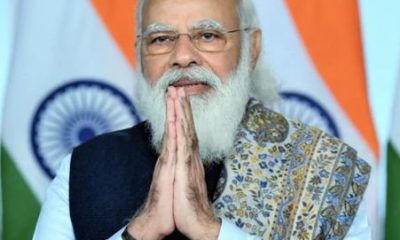World
‘Need to step up speed on India, Nepal, China corridor’

Beijing: India, China and Nepal should go ahead and order a feasibility study for an economic corridor among the three nations that will benefit its people, a senior Chinese official said here.
Huang Xilian, deputy director-general in the Department of Asian Affairs at the foreign ministry said that ties between India and China “were the most important bilateral relationship in the world” and that both the countries should step up efforts to strengthen these. “What we need is a heart-to-heart exchange between the two nations,” he added.
He said that the trilateral corridor was briefly discussed between President Xi Jinping and Prime Minister Narendra Modi during the latter’s visit to China, but it was time to move the proposal forward.
He said the corridor could comprise road and rail links from China to Nepal, under the Himalayas, and then India. It could also link the three through air connectivity and people to people exchanges.
He said the nearest rail link to Nepal in China was today around 300 km away but technically it posed no problem. “It would be a dream come true” for the people of the three nations.
He said India and China need to step up consultations on this, apart from ordering a feasibility study as a first concrete step. “China is ready for this,” he said. “Close neighbours,” he said, were more important than relatives.
Talking of the trade gap between India and China, which was in favour of the latter, Xilian said that his country had encouraged local companies to do business with India. He wants to see many of the large companies to set up base in India too. ‘Made in India’ and ‘Made in China’ should be combined, he said.
“The main word between the two economies, is ‘development’,” he said.
China would be importing some $10 trillion of goods over the next five years and Indian companies should take advantage of this to balance some of the trade, he said.
On the border question, Xilian said that this would be a topic for others in the ministry to answer, but his brief stand was that there should be peace and tranquillity along the India-China border.
He said a mechanism existed between the two countries to look at all the issues relating to the border and the two countries should look for closer cooperation through that. “We seek a reasonable solution between the two sides as early as possible,” Xilian said.
He said the recent earthquake in Nepal had shown how vulnerable the mountain nation was and India he said had given timely help and had been generous and magnanimous in its approach to the smaller nation. Both China and India, he said, need to help Kathmandu cope with the tragedy and the recent donor conference which he had attended with his foreign minister showed how this could be done.
He said his minister had met his Indian counterparts in Kathmandu to discuss several issues of mutual concern and the question of the India-Nepal-China economic corridor had also briefly come up.
World
Lockdowns in China Force Urban Communities to Defy Censorship and Vent Frustration Online

Shanghai’s rich middle class is leading a wave of online dissent over the strict and prolonged lockdowns imposed in various parts of the country. Chinese internet censorship is struggling as patience is wearing thin in many urban centers, coming up with creative forms of online protests.
Social Media Posts Revealing Lockdown Tension in Shanghai
Drawn-out lockdowns are nothing new in China as authorities insist with the nation’s zero-Covid policy since the start of the pandemic. Currently over This time around, however, metropolitan areas like Shanghai are increasingly difficult to keep quiet, given that its more than 25 million residents have seen weeks of total isolation along with food shortages and many other service interruptions.
Dozens of towns and reportedly over 300 million Chinese citizens have been affected by lockdowns of different severity. As expected, urban netizens have been most outspoken over their difficulties by finding creative ways to get around state censorship and bans placed on topics, news comments and spontaneous campaigns.
Shanghai residents have been using mobile proxies and hijacking seemingly unrelated hashtags to talk about healthcare issues, delivery failures and the overall severity of their situation. The “positive energy” that the Chinese government wants to transmit during the recent prolonged series of lockdowns does not come naturally to those counting food supplies and online censors are working hard to filter words, trending topics and undesired social media sharing.
WeChat groups and message threads are under constant monitoring. Posts questioning the zero-Covid approach have been quickly deleted, including by leading Chinese health experts like Dr. Zhong Nanshan. Video footage is soon censored and protests and investigations are quickly made to disappear.
Where this has not worked, officials have exposed banners with warnings and outright threats like “watch your own mouth or face punishment”, while drones have been patrolling the city skies. Yet, if anything, this has led to further tensions and unspoken confrontation with Shanghai’s educated and affluent middle class.
Creative Online Solutions Harnessing Civic Energy
Announcements by Chinese social media that they would be publishing the IP addresses of users who “spread rumors” have not helped either. Tech industry research has shown that much of Asia’s tech-savvy population has a habit of using mobile proxies and other privacy tools, quickly finding workarounds to browse the internet freely and talk to the world about the hottest topics.
The sheer volume of forbidden posts is already a challenge for the very censorship system, experts explain. Unable to track all trending hashtags, state workers overlook topics that speak about the US, Ukraine or other popular news. Linking human rights elsewhere to their situation, Chinese online dissidents establish their informal channels and “hijack” the conversation to share personal or publicly relevant information about the Covid suppression in their town.
Sarcastic and satirical posts still dominate. Others hope to evade the censors by replacing words from famous poems or the national anthem. One thing is certain – social media, when harnessed with the right creativity, has proven its ability to mount pressure on the government in even some of the most strictly controlled tech environments like China.





















